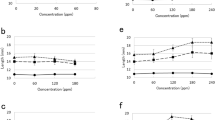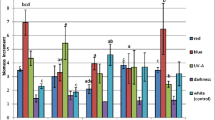Summary
Culture supernatants ofAzotobacter vinelandii andAzotobacter beijerinckii contain auxins, at least three gibberellin-like substances and three cytokinin-like substances. Treating roots of tomato seedlings with these cultures accelerates plant growth and increases yield of fruit, effects probably caused by activity of the plant hormones. Amounts of hormones produced in these cultures are similar to those produced byAzotobacter chroococcum andAzotobacter paspali.
Similar content being viewed by others
References
Azcón, R., Barea, J. M. and Callao, V., Selection of phosphate-solubilizing and nitrogen-fixing bacteria for using as biological fertilizers. (Spanish with an English summary). Cuad. C. Biol.2.1, 23–30 (1973).
Barea, J. M. and Brown, M. E., Effect on plant growth produced byAzotobacter paspali related to synthesis of plant growth regulating substances. J. Applied Bacteriol.37, 583–593 (1974).
Barea, J. M., Navarro, E., Palomares, A. and Montoya, E. A., rapid microbiological assay method for auxins, gibberellic acid and kinetin using yeast. J. Applied Bacteriol.37, 171–174 (1974).
Brian, P. W. and Hemming, H. G., Promotion of cucumber hypocotyl growth by two new gibberellins. Nature189, 74 (1961).
Brown, M. E. and Burlinghan, S. K., Production of plant growth substances byAzotobacter chroococcum. J. Gen. Microbiol.53, 135–144 (1968).
Brown, M. E., Burlinghan, S. K. and Jackson, R. M., Studies on Azotobacter species in soil I. Plant and Soil17, 309–319 (1962).
Brown, M. E., Burlinghan, S. K. and Jackson, R. M., Studies on Azotobacter species in soil II. Plant and Soil17, 320–331 (1962).
Brown, M. E. and Walker, N., Indolyl-3-acetic acid formation byAzotobacter chroococcum. Plant and Soil32, 250–253 (1970).
Callao, V., Montoya, E. and Hernandez, E., A rapid identification method for Azotobacter, (Spanish with English, French and German summaries). Agrochimica6, 51–55 (1961).
Coppola, S., Percuoco, G., Zoina, A. and Picci, G., Citochinine in germi terricoli e relativo significato nei rapporti piante-microorganismi. Annali Microbiol.21, 45–53 (1971).
De Ley, J., DNA base composition and classification of some more free-living nitrogen-fixing bacteria. Antonie van Leeuwenhoek J. Microbiol. Serol.34, 66–70 (1968).
De Ley, J. and Park, I. W., Molecular biological taxonomy of some free-living bacteria. Antonie van Leeuwenhoek J. Microbiol. Serol.32, 6–16 (1966).
Frankland, B. and Wareing, P. F., Effect of gibberellic acid on hypocotyl growth of lettuce seedlings. Nature185, 255–256 (1960).
Hemberg, T. and Westlin, P. E., The quantitative yield in purification of cytokinins, model experiments with kinetin. Physiol. Plantarum28, 228–231 (1973).
Hewitt, E. J., Sand and water culture method used in the study of plant nutrition. Technical Communication22. Farnhan Royal, Bucks: Commonwealth Agricultural bureau (1952).
Jackson, R. M., Brown, M. E. and Burlinghan, S. K., Similar effects on tomato plants of Azotobacter inoculation and application of gibberellins. Nature203, 851–852 (1964).
Lee, M., Breckenridge, C. and Knowles, R., Effect of some culture conditions on the production of indole-3-acetic acid and a gibberellin-like substance by Azotobacter vinelandii. Can. J. Microbiol.16, 1325–1330 (1970).
Lethan, D. S., Regulators of cell division in plant tissues XII. Physiol. Plantarum25, 391–396 (1971).
Navarro, E., Barea, J. M. and Montoya, E., A method for cytokinins extraction from bacterial cultures. (Spanish). Abstracts IV National Congress of Microbiology. Granada, Spain (1973).
Nitsch, J. P. and Nitsch, C., Studies on the growth of coleoptile and first internode sections. A new, sensitive, straight-growth test for auxins. Plant Physiol.31, 94–111 (1956).
Norris, J. R. and Chapman, H. M.,in Identification Methods for Microbiologists, Part. B (Gibbs, B. M. and Shapton, D. A. ed.). Academic Press, London, 19–27 (1968).
Rueda, E. and Rueda, J. M., Cultivos enarenados de hortalizes extratempranas. Mundiprensa ed. Madrid, Spain (1965).
Wheeler, A. W., Changes in growth-substances contents during growth of wheat grains. Ann. Applied Biol.72, 327–334 (1972).
Author information
Authors and Affiliations
Rights and permissions
About this article
Cite this article
Azcón, R., Barea, J.M. Synthesis of auxins, gibberellins and cytokinins byAzotobacter vinelandii andAzotobacter beijerinckii related to effects produced on tomato plants. Plant Soil 43, 609–619 (1975). https://doi.org/10.1007/BF01928522
Received:
Issue Date:
DOI: https://doi.org/10.1007/BF01928522




